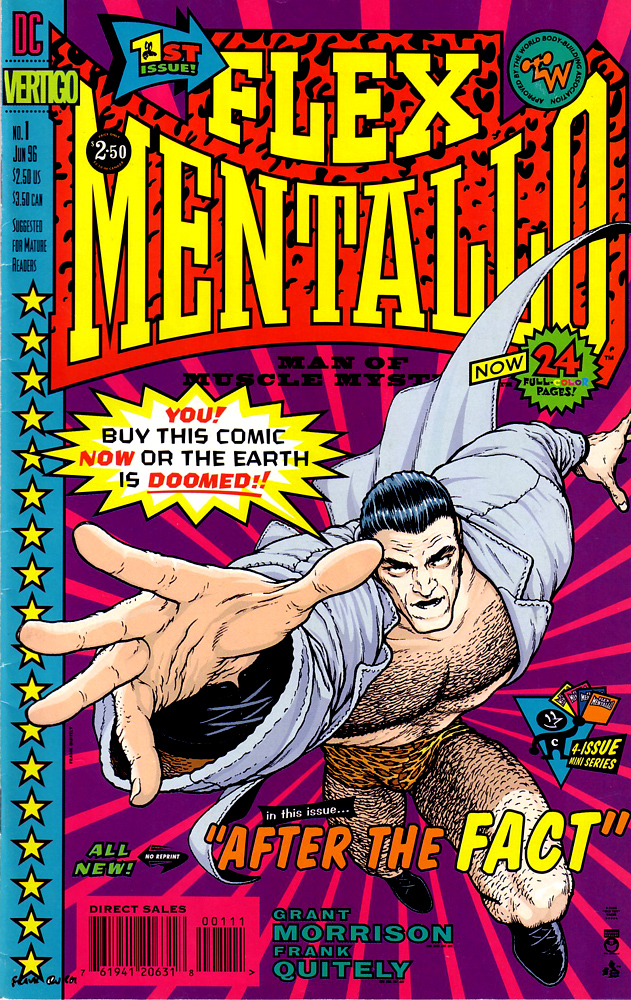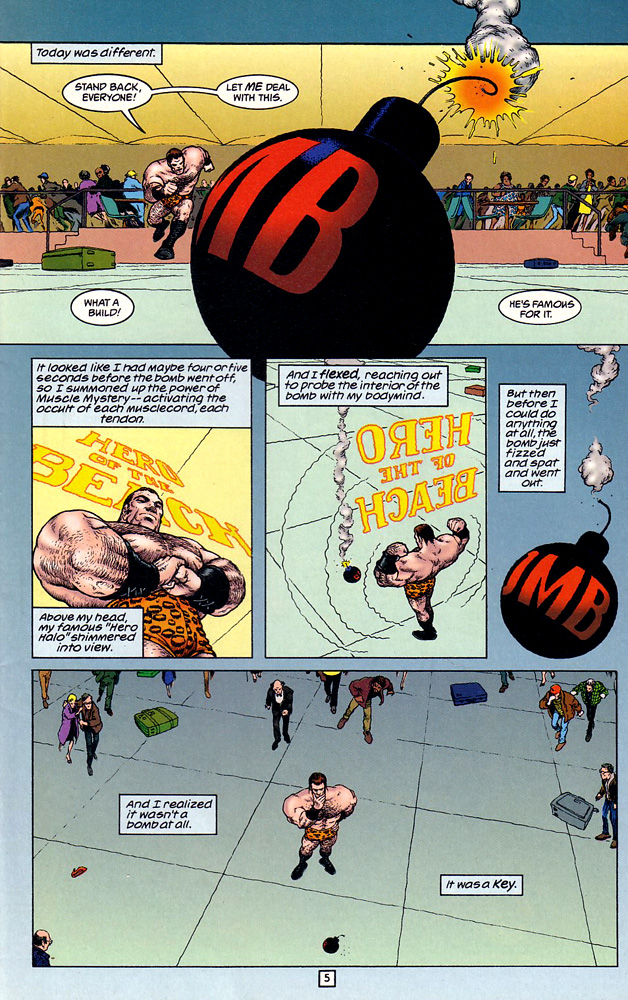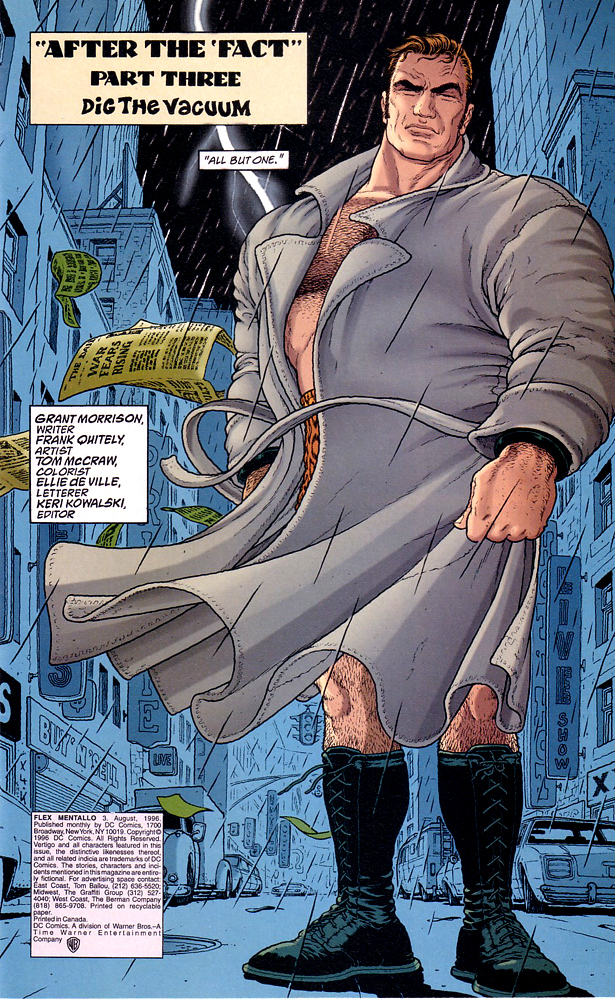 Reading Flex Mentallo is what I imagine being on LSD is like. Only less intense and happening on paper. But that doesn’t change the fact that Flex Mentallo made my brain feel like it was looping in on itself – a brain Moebius
Reading Flex Mentallo is what I imagine being on LSD is like. Only less intense and happening on paper. But that doesn’t change the fact that Flex Mentallo made my brain feel like it was looping in on itself – a brain Moebius
strip, if you will – and in that sense it was super trippy.
But let’s take a step back. As we briefly explained in the Grant Morrison show, Flex Mentallo is a character that first appeared in the pages of Doom Patrol #35. He was based on those old Charles Atlas ads you’d find in comic books where the skinny guy works out and stops people from pushing him around when he’s at the beach with his girl. In 1996, Flex was then spun off into this four part, self-titled mini-series, written by Grant Morrison with art by Frank Quitely, which existed in a completely separate continuity than Doom Patrol. Or maybe not. I have a hard time making any firm assertions about this book.
 Someone who shall remain nameless was such a big fan of the mini-series that he brought it to the attention of the Charles Atlas Company and well… they weren’t too happy about it and brought legal action against DC Comics. DC won the case on grounds of parody, but has still not reprinted the mini, nor will they even talk about it.
Someone who shall remain nameless was such a big fan of the mini-series that he brought it to the attention of the Charles Atlas Company and well… they weren’t too happy about it and brought legal action against DC Comics. DC won the case on grounds of parody, but has still not reprinted the mini, nor will they even talk about it.
So what’s all the hubbub about?
Well, I’ve only read the series once and I feel like I need to read it a few more times to really absorb it all and pick up on all the references and commentaries but the story is this:
Flex Mentallo is a superhero who goes around in old 50s style leopard print swim trunks and wrestling boots and whose main super power seems to be that he can effect reality when he flexes his giant  muscles, which I would just like to say is really fucking awesome. The first time he displays his power I was bit confused. Did he just make a muscle and then did that… *long pause*… awesome. When he engages his awesome muscley might, a big flashy “Hero of the Beach” sign appears above him. Right off the bat you know that Grant Morrison is going to be going full speed ahead and you, the reader, are going to be hanging onto this one for dear might.
muscles, which I would just like to say is really fucking awesome. The first time he displays his power I was bit confused. Did he just make a muscle and then did that… *long pause*… awesome. When he engages his awesome muscley might, a big flashy “Hero of the Beach” sign appears above him. Right off the bat you know that Grant Morrison is going to be going full speed ahead and you, the reader, are going to be hanging onto this one for dear might.
There are many things happening in Flex Mentallo, but there are only really two storylines happening concurrently. The first is with Flex Mentallo himself. Some unknown people are terrorizing the city with fake bombs and Flex finds a clue at the scene of one of the fake bombings which leads him on the search for his missing partner, a superhero known as The Fact. Meanwhile, a tormented musician named Wallace Sage has just taken every legal and illegal drug in his apartment and has wandered — in drug-induced stupor – into an alleyway waiting for death to overtake him, all the while babbling away on the phone to someone about his impending death. These are the two storylines that we follow throughout the entire four issue series.
 As the story progresses many things start to come into question. Like your sanity. Wallace Sage weaves a harrowing tale of existence to whomever he’s talking to on the phone. In it we find out that he is obsessed with comic books and as a kid he would make his own. We are treated to flashbacks of his comic book making and we discover that not only did he create Flex Mentallo as a kid but he wrote and drew some of the scenes in the very comic book you are holding. But clearly Flex and Wallace are in the same world! What is going on here?!?
As the story progresses many things start to come into question. Like your sanity. Wallace Sage weaves a harrowing tale of existence to whomever he’s talking to on the phone. In it we find out that he is obsessed with comic books and as a kid he would make his own. We are treated to flashbacks of his comic book making and we discover that not only did he create Flex Mentallo as a kid but he wrote and drew some of the scenes in the very comic book you are holding. But clearly Flex and Wallace are in the same world! What is going on here?!?
I don’t want to get too far into spoiling what exactly is going on here (and I don’t know if I could say “exactly” for certain, but I could give you a good guess) because I know that a lot of people have not read this and I think if you can get your hands on it, it is worth experiencing without knowing what is coming.
What I can say is that Flex Mentallo is Grant Morrison at his metaphysical prime. This is a worthy companion piece to Animal Man (and I assume The Invisibles, though I haven’t read it but I really want to) in Morrison’s exploration of existence and what it truly means to be alive and the blurry line  between fiction and reality. Is Flex real? Is Wallace? Are they both real? Did Flex spring forth from Wallace’s imagination? That’s really what the book is about. It’s also about comic books themselves, which is something Morrison really likes to explore. The first issue is a very clear treatise on the straight forward black & white heroics of the Golden Age of comics, the second issue enters the wackier Silver Age, the third issue explores the Bronze/Dark Age with the homage to The Dark Knight Returns on the cover and in one scene in the issue (as well as non-specifically in the overall tone of the issue), and the fourth and final issue examines the as yet undefined Modern Age which is really where the relationship between fiction and reality is explored. It’s all very heady stuff, but also very exciting and quite interesting.
between fiction and reality. Is Flex real? Is Wallace? Are they both real? Did Flex spring forth from Wallace’s imagination? That’s really what the book is about. It’s also about comic books themselves, which is something Morrison really likes to explore. The first issue is a very clear treatise on the straight forward black & white heroics of the Golden Age of comics, the second issue enters the wackier Silver Age, the third issue explores the Bronze/Dark Age with the homage to The Dark Knight Returns on the cover and in one scene in the issue (as well as non-specifically in the overall tone of the issue), and the fourth and final issue examines the as yet undefined Modern Age which is really where the relationship between fiction and reality is explored. It’s all very heady stuff, but also very exciting and quite interesting.
I would be remiss and deserving of a kick in the junk if I did not comment on the art by Frank Quitely. Oh, no… here he goes again! I can hear you, Quitely critics! The fact of the matter is that the guy is one of my favorite artists working today (possibly of all time) and he is certainly in top form in Flex Mentallo. Let’s face it, on the surface and in this modern age, Flex looks kind of ridiculous in his leopard skin trunks and wrestling boots, but Quitely makes it work and makes Flex look heroic and almost mythical. Flex Mentallo is a comic book full of big panels with lots of detail. Lately it seems like Quitely has eschewed backgrounds (and maybe it’s a time saving measure) and  there are certainly some panels here without backgrounds but the majority are crammed full of little details that bring the pages to life. Not literally. Well, maybe. I’m still not sure if my reading this book caused me to summon forth any fictional characters.
there are certainly some panels here without backgrounds but the majority are crammed full of little details that bring the pages to life. Not literally. Well, maybe. I’m still not sure if my reading this book caused me to summon forth any fictional characters.
If anyone sees a big guy in leopard print trunks and wrestler boots walking around their town, send me an e-mail.
I don’t believe we’re looking at a re-release of this book by DC Comics anytime soon, if ever, which is too bad because it deserves to be read by a much wider audience. Ron mentioned that the scarcity and the legend around this book is pushing it into Miracle Man status. I don’t know if that’s true or not but I do know that like Miracle Man, Flex Mentallo is a compelling work by one of the best writers of the modern era. I imagine that the longer it stays under legal wraps, the greater its legend will grow.
If your Grant Morrison library features Animal Man, Doom Patrol, The Invisibles, and The Filth, it’s not complete until you get your hands on some copies of Flex Mentallo #1-4.


Conor, excellent review! How did you come by this comic? This is my most saught after comic book work. I find the concept absolutely facinating but i can’t find it anywhere (for an affordable price that is). Anyone have any advice?
I have these here in the Tiki hut. I think I’m gonna have to dig them out again. 🙂 Great review Conor.
the Tiki
@thefreakytiki: Wanna sell ’em 😉
Holy wow. We have discovered the rarest beast of all: the Back Issue That Is Still Expensive.
http://search.ebay.com/search/search.dll?from=R40&_trksid=m37&satitle=flex+mentallo&category0=
WOW! Great review Conor. Flex Mentallo sounds very intersting. It seems the more i hear about Grant Morrison the more i like him.
Really great piece, Conor. Now what we really need is someone to talk about THE FILTH, becuase I’ve tried at least 3 times and that issomething I just can’t wrap my head around.
Oh, and thank you for recommending Morrison’s run on JLA – I read the first two trades and it’s great!
You almost have to take the MM route to actually read these. I did and it’s one of my favorite pieces of work, of all time. Charles Atlas FTL.
I look forward to reading this in 30 years when it finally gets collected.
@DoctorPym You only had to wait 3 years
Make that 4 years!